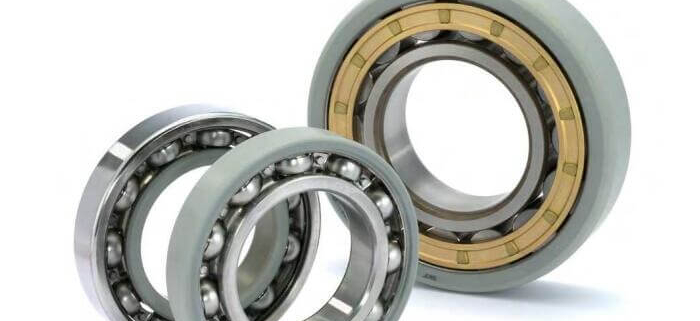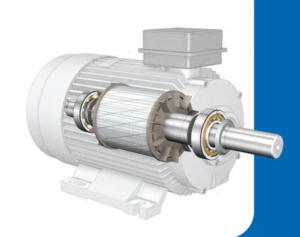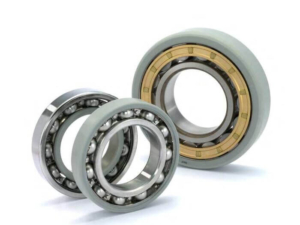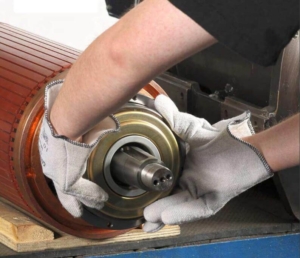Electric Motor bearing Application and Installation
Electric Motor bearing, also known as motor bearing or electrical motor bearing, is a special bearing applied to motor. The bearing used by the motor is a part that supports the shaft, it can guide the rotation of the shaft, and can also withstand the idle components on the shaft.
There are four types of bearings commonly used in motors, namely:
— Rolling bearings,
— Sliding bearings,
— Joint bearings( spherical plain bearing)
— Oil bearings.
The most common motor bearings are rolling bearings, that is, bearings with rolling elements.
— Deep groove ball bearing
— Cylindrical roller bearing
— Insulated bearing
— Hybrid bearings
— Angular contact ball bearings
— Spherical roller bearings
— CARB toroidal roller bearings
— Spherical roller thrust bearings
Operation principle of the Motor Bearing
Motor bearings use smooth metal balls or rollers and lubricated inner and outer ring metal surfaces to reduce friction. These balls or rollers “carry” the load and support the motor shaft so that the motor (rotor) can rotate smoothly.
Electric Bearing Type
— Most small and medium motors use rolling bearings.
— Large and medium-sized motors also use rolling bearings.
— Ball bearings (such as deep groove ball bearings) are used for bearings at both ends of small motors.
— Medium-sized motors use roller bearings at the load end (such as cylindrical roller bearings and tapered roller bearings. Generally used for high load conditions), and non-load ends use ball bearings (but there are also opposite cases, such as 1050kW motors). Rolling bearings are lubricated with grease, but they are also lubricated with lubricating oil.
Bearing Installation
The quality of the Electric Motor bearing installation will directly affect the accuracy, life and performance of the bearing. Therefore, please fully study the bearing installation, that is, please install the motor bearing in accordance with the operating standards including the following items:
1. Clean the motor bearings and related parts. Oil-lubricated bearings and oil seals or dust caps on both sides of the grease-lubricated bearings are not required before the seal ring bearings are installed.
2. Check the size and finishing of related parts
Installation Method:
The installation of the motor bearing should be based on the bearing structure, size and the matching nature of the bearing components. The pressure should be directly applied to the end surface of the tightly fitting ring, and the pressure should not be transmitted through the rolling element. The motor bearing installation generally adopts the following methods:
- Press fit
When the inner ring of the motor bearing is tightly matched with the shaft, and the outer ring is loosely fitted with the bearing seat hole, the motor bearing can be pressed on the shaft with a press, and then the shaft and the bearing are installed into the bearing seat hole together. At the end face of the inner ring of the motor bearing, a soft metal material assembly sleeve (copper or mild steel) is placed.
When the outer ring of the motor bearing fits tightly with the hole of the bearing seat, when the inner ring is loosely fitted with the shaft, the motor bearing can be pressed into the hole of the bearing seat first, then the outer diameter of the assembly sleeve should be slightly smaller than the diameter of the seat hole.
If the bearing ring of the motor is tightly matched with the shaft and the seat hole, the inner ring and the outer ring should be pressed into the shaft and the seat hole at the same time during installation. The structure of the assembly sleeve should be able to press the end surfaces of the inner and outer rings of the bearing .
- Heating coordination
By heating the motor bearing or bearing seat, the thermal expansion is used to transform the tight fit into a loose fit installation method. It is a common and labor-saving installation method.
This method is suitable for the installation of motor bearings with a large interference. Before hot assembly, put the bearing ring of the motor bearing or the separable bearing in the oil tank and heat it evenly at 80-100 ℃, then remove it from the oil and install it on the shaft as soon as possible. In order to prevent the end face of the inner ring and the shaft shoulder from being tight after cooling, the motor bearing can be axially tightened after cooling. When the outer ring of the motor bearing is tightly matched with the bearing seat made of light metal, the hot-fitting method of heating the bearing seat can be used to avoid scratches on the mating surface.
When heating the motor bearing with an oil tank, there should be a grid at a certain distance from the bottom of the tank, or use a hook to hang the motor bearing. The motor bearing cannot be placed on the bottom of the tank to prevent sunken impurities from entering the motor bearing or uneven heating. There must be a thermometer, and the oil temperature must be strictly controlled not to exceed 100 ° C to prevent the tempering effect and reduce the hardness of the ferrule.






